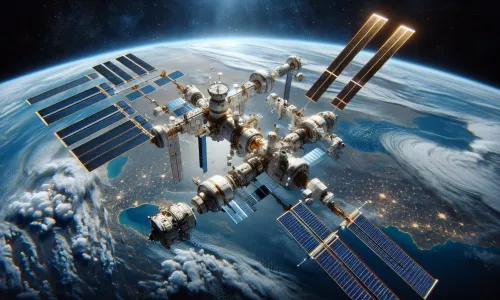Answers For The Challenges of Living in Space
Answers and detail explain for The Challenges of Living in Space
EXPLAIN
The Challenges of Living in Space

SPEAKER: Hello, everyone. So I'd like to tell you about some of the challenges of living in space. We'll start with the International Space Station, or ISS, as it's often called. The ISS has been in space in orbit around the Earth since 1998. Over 1200 astronauts have lived on board, and one of the biggest challenges for them is living in microgravity. So, what happens when you're living in microgravity 24 hours a day for months?
For a start, it affects your blood circulation on Earth. Your blood would naturally be pulled towards your feet. But in space it goes to your head and we'll talk a bit more about the consequences of that later. But it also 1goes to your chest. And that's why astronauts have to be careful about their blood pressure.
Microgravity also affects the minerals stored inside your body over time. For example, 2the amount of calcium inside your bones begins to decrease, so the bones become weaker. Yes, it's not much fun living in space. The astronauts have to maintain a very strict exercise program. They do 2.5 hours of exercise six days a week if they don't, what happens is that their 3muscle begins to waste. Some of it also turns into fat.
And one final problem that some astronauts experience, they find that when they get back to Earth, 4they can't see clearly. Scientists aren't exactly sure why this happens, but it seems that the 4astronauts' vision can be permanently affected.
Another challenge with the living in the ISS is you have to take everything you need with you. So space agencies like NASA are constantly improving the way they recycle things. Water, of course, is a vital resource, and every little bit counts. That means that 5even the sweat that the astronauts produce is recycled. I know that doesn't sound very nice, but NASA says their water is purer than anything you'd drink on Earth.
So, what's next? Humans are already living in space in the space station, but now the goal is to live on the Moon or Mars. For this, we need to make buildings. And the challenges for engineers and architects are even harder. It's incredibly expensive to transport materials into space, 6so they need to be as light as possible. The alternative is to use materials which already exist on the moon or mars. And this does seem to be the sensible way forward.
So to make buildings on the moon, for example, we could use rock, and the moon also has plenty of useful minerals. These can be made into metal into brick. And some engineers are also suggesting they could 7produce paint. So it seems everything we need for a basic building might already be on the moon. Actually, there's one thing that NASA hasn't managed yet, and that's to 8increase the size of the windows on the ISS, they're very small. And if people were going to live in buildings on the moon, this is something NASA still has to work on.
So, even if we managed to create a network of buildings for people to live in on the Moon or Mars and grow food and be self-sufficient, they would still need mental stimulation and opportunities to relax and stay in touch with what was happening back on Earth. Virtual reality could be the answer. Imagine you're living on the moon, but you could use virtual reality to 9walk around a museum and see all the exhibits. That would be incredible. And by using virtual reality, you could continue your education by, say, 10studying for a qualification that might be useful in your current environment, or once you're back on Earth. Now Mars is a different thing....
Questions 1 - 10:
Complete the notes below. Write ONE WORD ONLY for each answer.
Living on the International Space Station (ISS)• Astronauts spend months in microgravity, so Building on the moon or Mars• Engineers and architects must either use materials which |